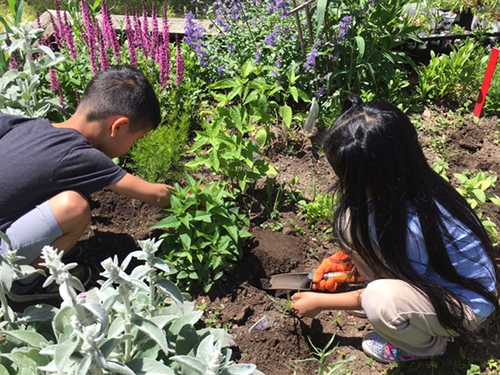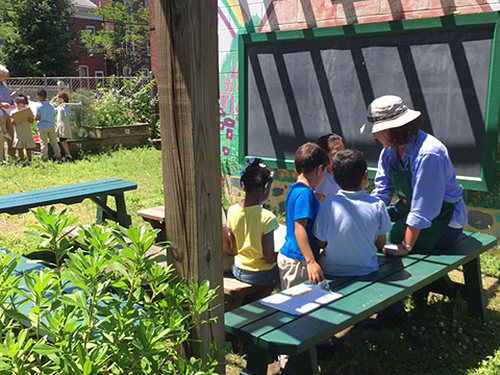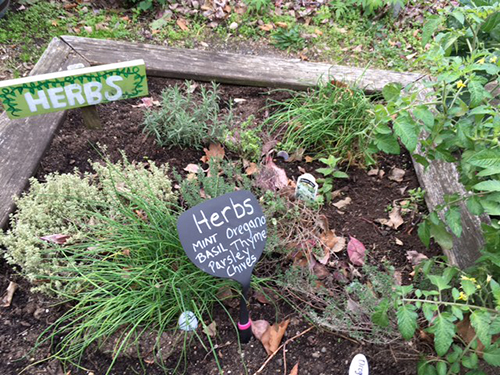
Fact Sheet FS1345
School gardens are a wonderful way of educating students on how to grow and eat nutritious fruits and vegetables. Good gardening practices should include produce safety risk-reduction measures and emphasize concepts that will help students make healthier fresh food choices. Human pathogens can be unknowingly transferred from the environment, or an ill person, potentially causing illness to those who eat the contaminated produce. Specific practices to reduce the risk of foodborne pathogen contamination in the garden are discussed. In addition, a checklist that can be used to assess current gardening practices and how to plan for future adoption of additional risk reduction activities is provided. Prevention practices are an important part of producing high-quality produce.
Student, Staff, and Garden Volunteer Health and Hygiene
Proper education for staff, students, and garden volunteers is important to reduce the potential of bringing pathogens into the garden and contaminating produce, surfaces, and other people. Staff involved with overseeing gardening activities are key to growing produce that is safe for consumption. Staff should be trained on proper health and hygiene practices as well as safe gardening practices. These practices should be taught to the students with staff serving as good role models.
| Produce Safety Education and Health and Hygiene Activities | Yes | No | Actions Needed |
|---|---|---|---|
| All staff and volunteers who are involved with decision-making in the garden have had produce safety education. | |||
| All non-decision-making staff, volunteers, and students who use the garden space are trained on practices to reduce human pathogen risks specific to their garden. | |||
| Handwashing stations are readily available and well-stocked so that gardeners can wash their hands when needed. | |||
| A first aid kit is on-site, stocked, and includes single-use gloves to be utilized when a hand needs to be bandaged and then covered by the glove. | |||
| Ill gardeners report their symptoms to a garden supervisor and do not work in the garden when sick. |
Water Source and Use
Water that touches the edible portion of the plant, particularly produce that is consumed raw, should come from a tested source, and meet the quality standards listed below. Water can carry and spread human pathogens throughout the garden and onto produce. The quality of water should be known for water used in irrigation, water used to mix pesticides, and water used to wash the produce once it has been harvested.
| Water Usage | Yes | No | Actions Needed |
|---|---|---|---|
| Well water used in the garden is tested for generic E. coli once a year, and has a non-detectable generic E.coli result. | |||
| Harvested rainwater (rain barrel/cistern) does not touch the edible portion of the crop when used for irrigation. | |||
| Annual water quality reports are obtained for municipal or public water sources. | |||
| Use food-grade containers to transport water throughout the garden. Do not repurpose non-foodgrade containers for water transport. |
Compost Handling and Use
Composting is an excellent way to take garden waste and convert it into available nutrients for crops. Composting sometimes includes animal manures as an ingredient. Animal manures can be a source of human pathogens and should be handled with care. When composting with animal manures, thought should be given as to how ingredients are transported, handled, and processed to minimize potential for cross-contamination of tools, surfaces, and footwear. Please check with the school administration for approvals prior to composting with animal manures.
| Composting with Animal Manures (N/A If Not Using Manures) | Yes | No | Actions Needed |
|---|---|---|---|
| Composting activities that include the use of animal manures follow the National Organic Program protocols for handling of raw animal manures and the timing of application into food producing areas. | |||
| Compost that includes animal manure inputs is applied to the garden in the fall after all edible produce has been removed. | |||
| Staff and students do not track raw animal manures into the food-producing areas through shoes, tools, equipment, etc. | |||
| Purchased composts made with raw animal manures have pathogen-testing reports available. |
Surface Sanitation
Contamination of surfaces that come in contact with produce pose a critical risk in the school garden environment. Food contact surfaces should be identified in the garden space through packaging and transport from the garden. To reduce contamination risks on these surfaces there should be a regular cleaning and sanitation schedule with instructions available on how and when to clean and sanitize these surfaces. Cleaning a surface is defined as using soap and detergent, along with scrubbing, to remove visible debris. Sanitation is defined as using a food-contact, surface-approved sanitizer according to label instructions following the cleaning process.
| Sanitation | Yes | No | Actions Needed |
|---|---|---|---|
| Produce contacts only surfaces/containers designated for produce. | |||
| Plastic shopping bags are not reused for produce harvesting and distribution. Use containers that can be cleaned and sanitized between uses. | |||
| Containers used to hold produce are stored in a location that is free from rodents/wildlife. | |||
| Containers used to hold produce are cleaned and sanitized on a regular basis with a sanitizer that is labeled for use on food contact surfaces. | |||
| Garden tools and harvesting implements are stored in a designated location and are cleaned and sanitized as needed. | |||
| A surface-appropriate detergent is used for cleaning. | |||
| The sanitizer used has label instructions that indicate it is appropriate for food-contact surfaces. | |||
| The sanitizer label instructions are followed fully. | |||
| Water used for washing produce has a lab report showing that E. coli was non-detectable in the source. |
Wildlife and Other Animals
Domestic and wild animals pose a human health hazard if they defecate and/or feed on garden crops. These animals are carriers of human pathogens and can contaminate crops through direct contact or cross-contamination by tools, containers, hands, feet, etc. It can be impossible to completely prohibit their entry into a garden, but reasonable measures should be taken to exclude them and respond when contamination may have occurred.
| Wildlife and Other Animals | Yes | No | Actions Needed |
|---|---|---|---|
| Likely and common animals who would come into the garden have been identified. | |||
| Animal intrusion points have been identified and reasonable methods of control of these animals is taking place. | |||
| Produce that has been partially consumed, or has been contacted by animal fecal material, or is in close proximity to these fecal materials, is not harvested for consumption. | |||
| Reasonable efforts are made to keep wildlife and other pests out of the gardening space. | |||
| Weeds, trash, and other items are managed so that they do not become harborage points for wildlife and other animals. | |||
| The garden is located away from garbage receptacles, sewage, and septic systems. |
Growing nutritious, safe food in the school garden can be a very rewarding experience for students and staff in the school environment. Best practices for growing and handling fresh produce are a logical component of a school garden curriculum. An annual assessment of the gardening space and educational curriculum for its produce safety components is recommended. Produce safety best practices are common sense ways for everyone in the garden to reduce human pathogen risks and ensure quality, safe produce.
References and Resources
- USDA Food Safety Tips for School Gardens (PDF).
- E350: Food Safety, Soil, and Water Testing Recommendations for School and Community Gardens, Rutgers NJAES.
- FS1218: Rain Barrels Part IV: Testing and Applying Harvested Water to Irrigate a Vegetable Garden, Rutgers NJAES.
- Garden Supervisor Good Practices Training Video (YouTube link).
- ATTRA: Composting Tipsheet.
July 2022
Copyright © 2024 Rutgers, The State University of New Jersey. All rights reserved.
For more information: njaes.rutgers.edu.
Cooperating Agencies: Rutgers, The State University of New Jersey, U.S. Department of Agriculture, and Boards of County Commissioners. Rutgers Cooperative Extension, a unit of the Rutgers New Jersey Agricultural Experiment Station, is an equal opportunity program provider and employer.



